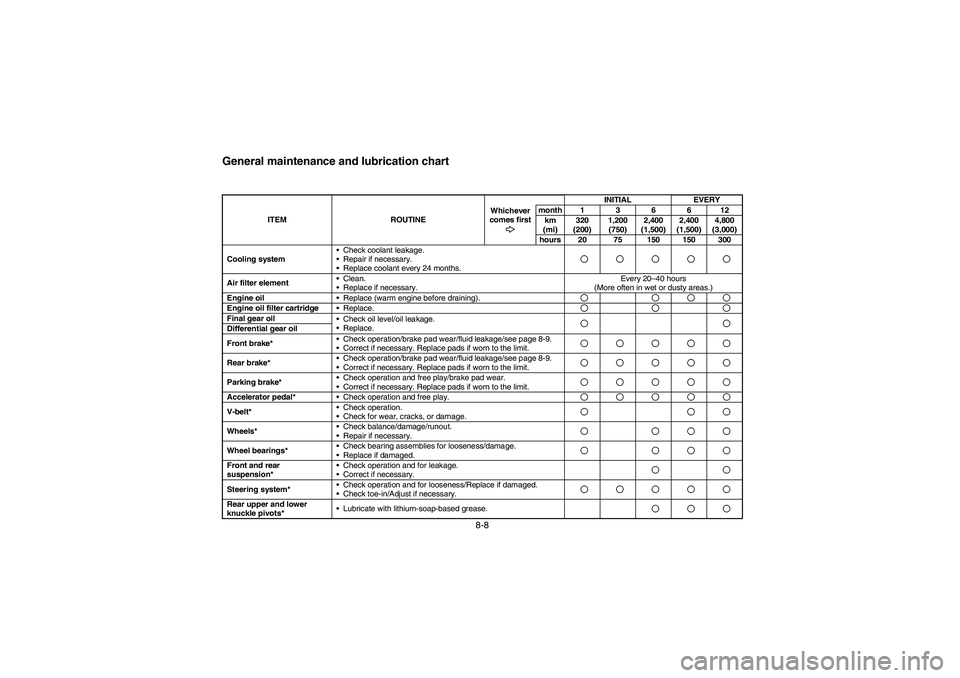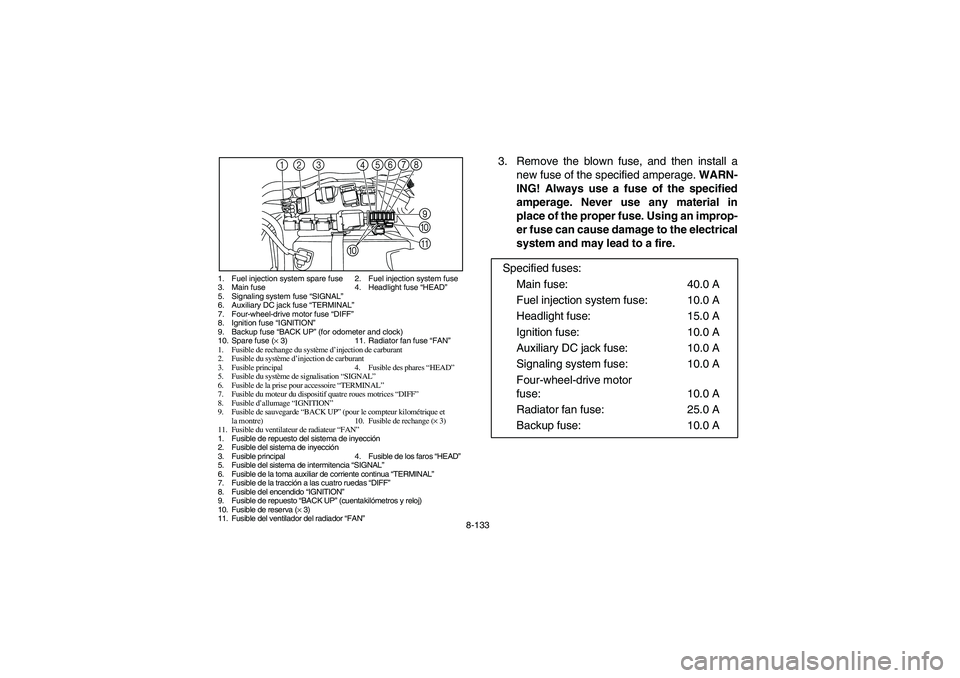Page 260 of 468
7-69
Loose terrain/slippery terrain
When driving on slippery terrain, including wet,
muddy, or icy conditions, as well as loose gravel,
be aware that you could begin skidding or sliding.
To avoid loss of control, slow down and put the
Rhino in 4WD before driving on a slippery surface
and plan your path to avoid making abrupt maneu-
vers.
If you feel the Rhino begin to slide sideways or the
back wheels slide during a turn, steer into the di-
rection of the slide if possible, to regain directional
control. For example, if you feel the back of the ve-
hicle start to slide to your right, steer to the right.
EE.book Page 69 Monday, October 8, 2007 4:48 PM
Page 273 of 468

8-8
EVU01650
General maintenance and lubrication chart
ITEM ROUTINEWhichever
comes firstINITIAL EVERY
month136612
km
(mi)320
(200)1,200
(750)2,400
(1,500)2,400
(1,500)4,800
(3,000)
hours 20 75 150 150 300
Cooling systemCheck coolant leakage.
Repair if necessary.
Replace coolant every 24 months.
Air filter elementClean.
Replace if necessary.Every 20–40 hours
(More often in wet or dusty areas.)
Engine oilReplace (warm engine before draining).Engine oil filter cartridgeReplace.Final gear oil
Check oil level/oil leakage.
Replace.Differential gear oil
Front brake*Check operation/brake pad wear/fluid leakage/see page 8-9.
Correct if necessary. Replace pads if worn to the limit.Rear brake*Check operation/brake pad wear/fluid leakage/see page 8-9.
Correct if necessary. Replace pads if worn to the limit.Parking brake*Check operation and free play/brake pad wear.
Correct if necessary. Replace pads if worn to the limit.Accelerator pedal*Check operation and free play.V-belt*Check operation.
Check for wear, cracks, or damage.Wheels*Check balance/damage/runout.
Repair if necessary.Wheel bearings*Check bearing assemblies for looseness/damage.
Replace if damaged.Front and rear
suspension*Check operation and for leakage.
Correct if necessary.Steering system*Check operation and for looseness/Replace if damaged.
Check toe-in/Adjust if necessary.Rear upper and lower
knuckle pivots*Lubricate with lithium-soap-based grease.
EE.book Page 8 Monday, October 8, 2007 4:48 PM
Page 352 of 468
8-87 1. Brake pad wear indicator groove
1. Rainure d’indication d’usure de plaquette de frein
1. Ranura indicadora de desgaste de la pastilla de freno
1
5B410019
Checking the front and rear brake pads
Each brake pad is provided with wear indicator
grooves, which allow you to check the brake pad
wear without having to disassemble the brake. To
check the brake pad wear, check the wear indica-
tor grooves. If a brake pad has worn to the point
that the wear indicator grooves have almost disap-
peared, have a Yamaha dealer replace the brake
pads as a set.
The wheels need to be removed to check the
brake pads. (See pages 8-111–8-117 for wheel re-
moval and installation procedures.)
EE.book Page 87 Monday, October 8, 2007 4:48 PM
Page 376 of 468
8-111
1. Nut (× 4)
1.Écrou (× 4)
1. Tuerca (× 4)
EVU00920
Steering shaft lubrication
Lubricate the pivot points.
EVU00930
Wheel removal
1. Loosen the wheel nuts.
2. Elevate the vehicle and place a suitable
stand under the frame.
3. Remove the nuts from the wheel.
4. Remove the wheel.Recommended lubricant:
Lithium-soap-based grease
EE.book Page 111 Monday, October 8, 2007 4:48 PM
Page 380 of 468
8-115
EVU00940
Wheel installation
1. Install the wheel and the nuts.�
The arrow mark on the tire must point to-
ward the rotating direction of the wheel.
�
Tapered nuts are used for both the front and
rear wheels. Install the nuts with their tapered
side towards the wheel.
2. Lower the vehicle so that the wheel is on the
ground.
3. Tighten the wheel nuts to the specified
torque.WARNING
Do not reverse the rims on the Rhino to widen
the track width. Installing wheels improperly
increases the risk of wheel failure and acci-
dents.
EE.book Page 115 Monday, October 8, 2007 4:48 PM
Page 382 of 468
8-117 1. Arrow mark
1. Flèche
1. Flecha
1. Tapered nut
1.Écrou conique
1. Tuerca cónica
Wheel nut torque:
Front: 55 Nm (5.5 m·kgf, 40 ft·lbf)
Rear: 55 Nm (5.5 m·kgf, 40 ft·lbf)
EE.book Page 117 Monday, October 8, 2007 4:48 PM
Page 398 of 468

8-133
1. Fuel injection system spare fuse 2. Fuel injection system fuse
3. Main fuse 4. Headlight fuse “HEAD”
5. Signaling system fuse “SIGNAL”
6. Auxiliary DC jack fuse “TERMINAL”
7. Four-wheel-drive motor fuse “DIFF”
8. Ignition fuse “IGNITION”
9. Backup fuse “BACK UP” (for odometer and clock)
10. Spare fuse (× 3) 11. Radiator fan fuse “FAN”
1. Fusible de rechange du système d’injection de carburant
2. Fusible du système d’injection de carburant
3. Fusible principal 4. Fusible des phares “HEAD”
5. Fusible du système de signalisation “SIGNAL”
6. Fusible de la prise pour accessoire “TERMINAL”
7. Fusible du moteur du dispositif quatre roues motrices “DIFF”
8. Fusible d’allumage “IGNITION”
9. Fusible de sauvegarde “BACK UP” (pour le compteur kilométrique et
la montre) 10. Fusible de rechange (× 3)
11. Fusible du ventilateur de radiateur “FAN”
1. Fusible de repuesto del sistema de inyección
2. Fusible del sistema de inyección
3. Fusible principal 4. Fusible de los faros “HEAD”
5. Fusible del sistema de intermitencia “SIGNAL”
6. Fusible de la toma auxiliar de corriente continua “TERMINAL”
7. Fusible de la tracción a las cuatro ruedas “DIFF”
8. Fusible del encendido “IGNITION”
9. Fusible de repuesto “BACK UP” (cuentakilómetros y reloj)
10. Fusible de reserva (× 3)
11. Fusible del ventilador del radiador “FAN”
3 2 17
9 5 468
A
@
0
3. Remove the blown fuse, and then install a
new fuse of the specified amperage. WARN-
ING! Always use a fuse of the specified
amperage. Never use any material in
place of the proper fuse. Using an improp-
er fuse can cause damage to the electrical
system and may lead to a fire.
Specified fuses:
Main fuse: 40.0 A
Fuel injection system fuse: 10.0 A
Headlight fuse: 15.0 A
Ignition fuse: 10.0 A
Auxiliary DC jack fuse: 10.0 A
Signaling system fuse: 10.0 A
Four-wheel-drive motor
fuse: 10.0 A
Radiator fan fuse: 25.0 A
Backup fuse: 10.0 A
EE.book Page 133 Monday, October 8, 2007 4:48 PM
Page 424 of 468
9-1
EVU01030
1-CLEANING AND STORAGE
A. Cleaning
Frequent, thorough cleaning of your vehicle will
not only enhance its appearance but will improve
its general performance and extend the useful life
of many components.
1. Before cleaning the vehicle:
a. Block off the end of the exhaust pipe to
prevent water entry. A plastic bag and
strong rubber band may be used.
b. Make sure the spark plug and all filler
caps are properly installed.
2. If the engine case is excessively greasy, ap-
ply degreaser with a paint brush. Do not ap-
ply degreaser to the wheel axles.
EE.book Page 1 Monday, October 8, 2007 4:48 PM